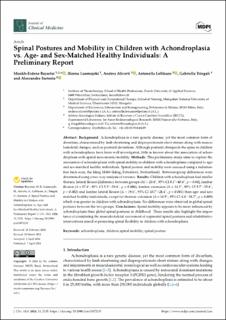Please use this identifier to cite or link to this item:
https://doi.org/10.21256/zhaw-30892| Publication type: | Article in scientific journal |
| Type of review: | Peer review (publication) |
| Title: | Spinal postures and mobility in children with achondroplasia vs. age- and sex-matched healthy individuals : a preliminary report |
| Authors: | Bayartai, Munkh-Erdene Luomajoki, Hannu Aliverti, Andrea LoMauro, Antonella Tringali, Gabriella Sartorio, Alessandro |
| et. al: | No |
| DOI: | 10.3390/jcm13072135 10.21256/zhaw-30892 |
| Published in: | Journal of Clinical Medicine |
| Volume(Issue): | 13 |
| Issue: | 7 |
| Page(s): | 2135 |
| Issue Date: | 7-Apr-2024 |
| Publisher / Ed. Institution: | MDPI |
| ISSN: | 2077-0383 |
| Language: | English |
| Subjects: | Achondroplasia; Children; Spinal mobility; Spinal posture |
| Subject (DDC): | 616.7: Diseases of musculoskeletal system and orthopaedics 618.92: Pediatrics |
| Abstract: | Background: Achondroplasia is a rare genetic disease, yet the most common form of dwarfism, characterized by limb shortening and disproportionate short stature along with musculoskeletal changes, such as postural deviations. Although postural changes in the spine in children with achondroplasia have been well investigated, little is known about the association of achondroplasia with spinal movements/mobility. Methods: This preliminary study aims to explore the association of achondroplasia with spinal mobility in children with achondroplasia compared to age- and sex-matched healthy individuals. Spinal posture and mobility were assessed using a radiation-free back scan, the Idiag M360 (Idiag, Fehraltorf, Switzerland). Between-group differences were determined using a two-way analysis of variance. Results: Children with achondroplasia had smaller thoracic lateral flexion [difference between groups (Δ) = 20.4°, 95% CI 0.1°-40.6°, p = 0.04], lumbar flexion (Δ = 17.4°, 95% CI 5.5°-29.4°, p = 0.006), lumbar extension (Δ = 14.2°, 95% CI 5.7°-22.8°, p = 0.002) and lumbar lateral flexion (Δ = 19.6°, 95% CI 10.7°-28.4°, p < 0.001) than age- and sex-matched healthy individuals, except for thoracic extension (Δ = 16.5°, 95% CI 4.4°-28.7°, p = 0.009) which was greater in children with achondroplasia. No differences were observed in global spinal postures between the two groups. Conclusions: Spinal mobility appears to be more influenced by achondroplasia than global spinal postures in childhood. These results also highlight the importance of considering the musculoskeletal assessment of segmental spinal postures and rehabilitative interventions aimed at promoting spinal flexibility in children with achondroplasia. |
| URI: | https://digitalcollection.zhaw.ch/handle/11475/30892 |
| Fulltext version: | Published version |
| License (according to publishing contract): | CC BY 4.0: Attribution 4.0 International |
| Departement: | School of Health Sciences |
| Organisational Unit: | Institute of Physiotherapy (IPT) |
| Appears in collections: | Publikationen Gesundheit |
Files in This Item:
| File | Description | Size | Format | |
|---|---|---|---|---|
| 2024_Bayartai-etal_Spinal-posture-mobility-in-children-with-achondroplasia.pdf | 1.12 MB | Adobe PDF |  View/Open |
Show full item record
Bayartai, M.-E., Luomajoki, H., Aliverti, A., LoMauro, A., Tringali, G., & Sartorio, A. (2024). Spinal postures and mobility in children with achondroplasia vs. age- and sex-matched healthy individuals : a preliminary report. Journal of Clinical Medicine, 13(7), 2135. https://doi.org/10.3390/jcm13072135
Bayartai, M.-E. et al. (2024) ‘Spinal postures and mobility in children with achondroplasia vs. age- and sex-matched healthy individuals : a preliminary report’, Journal of Clinical Medicine, 13(7), p. 2135. Available at: https://doi.org/10.3390/jcm13072135.
M.-E. Bayartai, H. Luomajoki, A. Aliverti, A. LoMauro, G. Tringali, and A. Sartorio, “Spinal postures and mobility in children with achondroplasia vs. age- and sex-matched healthy individuals : a preliminary report,” Journal of Clinical Medicine, vol. 13, no. 7, p. 2135, Apr. 2024, doi: 10.3390/jcm13072135.
BAYARTAI, Munkh-Erdene, Hannu LUOMAJOKI, Andrea ALIVERTI, Antonella LOMAURO, Gabriella TRINGALI und Alessandro SARTORIO, 2024. Spinal postures and mobility in children with achondroplasia vs. age- and sex-matched healthy individuals : a preliminary report. Journal of Clinical Medicine. 7 April 2024. Bd. 13, Nr. 7, S. 2135. DOI 10.3390/jcm13072135
Bayartai, Munkh-Erdene, Hannu Luomajoki, Andrea Aliverti, Antonella LoMauro, Gabriella Tringali, and Alessandro Sartorio. 2024. “Spinal Postures and Mobility in Children with Achondroplasia vs. Age- and Sex-Matched Healthy Individuals : A Preliminary Report.” Journal of Clinical Medicine 13 (7): 2135. https://doi.org/10.3390/jcm13072135.
Bayartai, Munkh-Erdene, et al. “Spinal Postures and Mobility in Children with Achondroplasia vs. Age- and Sex-Matched Healthy Individuals : A Preliminary Report.” Journal of Clinical Medicine, vol. 13, no. 7, Apr. 2024, p. 2135, https://doi.org/10.3390/jcm13072135.
Items in DSpace are protected by copyright, with all rights reserved, unless otherwise indicated.